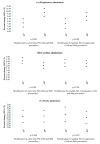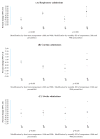The association between short and long-term exposure to PM2.5 and temperature and hospital admissions in New England and the synergistic effect of the short-term exposures
- PMID: 29929325
- PMCID: PMC6051434
- DOI: 10.1016/j.scitotenv.2018.05.181
The association between short and long-term exposure to PM2.5 and temperature and hospital admissions in New England and the synergistic effect of the short-term exposures
Abstract
Background: Particulate matter < 2.5 μm in diameter (PM2.5) and heat are strong predictors of morbidity, yet few studies have examined the effects of long-term exposures on non-fatal events, or assessed the short and long-term effect on health simultaneously.
Objective: We jointly investigated the association of short and long-term exposures to PM2.5 and temperature with hospital admissions, and explored the modification of the associations with the short-term exposures by one another and by temperature variability.
Methods: Daily ZIP code counts of respiratory, cardiac and stroke admissions of adults ≥65 (N = 2,015,660) were constructed across New-England (2001-2011). Daily PM2.5 and temperature exposure estimates were obtained from satellite-based spatio-temporally resolved models. For each admission cause, a Poisson regression was fit on short and long-term exposures, with a random intercept for ZIP code. Modifications of the short-term effects were tested by adding interaction terms with temperature, PM2.5 and temperature variability.
Results: Associations between short and long-term exposures were observed for all of the outcomes, with stronger effects of long-term exposures to PM2.5. For respiratory admissions, the short-term PM2.5 effect (percent increase per IQR) was larger on warmer days (1.12% versus -0.53%) and in months of higher temperature variability (1.63% versus -0.45%). The short-term temperature effect was higher in months of higher temperature variability as well. For cardiac admissions, the PM2.5 effect was larger on colder days (0.56% versus -0.30%) and in months of higher temperature variability (0.99% versus -0.56%).
Conclusions: We observed synergistic effects of short-term exposures to PM2.5, temperature and temperature variability. Long-term exposures to PM2.5 were associated with larger effects compared to short-term exposures.
Keywords: Cardiac; Hospitalizations; Particulate matter; Respiratory; Temperature.
Copyright © 2018 Elsevier B.V. All rights reserved.
Conflict of interest statement
The authors have no competing financial interests to declare
Figures



Similar articles
-
Mortality and Morbidity Effects of Long-Term Exposure to Low-Level PM2.5, BC, NO2, and O3: An Analysis of European Cohorts in the ELAPSE Project.Res Rep Health Eff Inst. 2021 Sep;2021(208):1-127. Res Rep Health Eff Inst. 2021. PMID: 36106702 Free PMC article.
-
Fine particulate air pollution and adult hospital admissions in 200 Chinese cities: a time-series analysis.Int J Epidemiol. 2019 Aug 1;48(4):1142-1151. doi: 10.1093/ije/dyz106. Int J Epidemiol. 2019. PMID: 31157384
-
Airborne Fine Particles and Risk of Hospital Admissions for Understudied Populations: Effects by Urbanicity and Short-Term Cumulative Exposures in 708 U.S. Counties.Environ Health Perspect. 2017 Apr;125(4):594-601. doi: 10.1289/EHP257. Epub 2016 Sep 20. Environ Health Perspect. 2017. PMID: 27649448 Free PMC article.
-
Short-term and long-term exposures to fine particulate matter constituents and health: A systematic review and meta-analysis.Environ Pollut. 2019 Apr;247:874-882. doi: 10.1016/j.envpol.2018.12.060. Epub 2018 Dec 21. Environ Pollut. 2019. PMID: 30731313
-
Short-term exposure to particulate matter (PM10 and PM2.5), nitrogen dioxide (NO2), and ozone (O3) and all-cause and cause-specific mortality: Systematic review and meta-analysis.Environ Int. 2020 Sep;142:105876. doi: 10.1016/j.envint.2020.105876. Epub 2020 Jun 23. Environ Int. 2020. PMID: 32590284
Cited by
-
Mortality attributable to fine particulate matter in Asia, 2000-2015: a cross-sectional cause-of-death analysis.BMJ Open. 2021 May 18;11(5):e043605. doi: 10.1136/bmjopen-2020-043605. BMJ Open. 2021. PMID: 34006545 Free PMC article.
-
Influences of temperature and humidity on cardiovascular disease among adults 65 years and older in China.Front Public Health. 2023 Jan 9;10:1079722. doi: 10.3389/fpubh.2022.1079722. eCollection 2022. Front Public Health. 2023. PMID: 36699927 Free PMC article.
-
Long-term exposure to PM2.5 and ozone and hospital admissions of Medicare participants in the Southeast USA.Environ Int. 2019 Sep;130:104879. doi: 10.1016/j.envint.2019.05.073. Epub 2019 Jun 22. Environ Int. 2019. PMID: 31238267 Free PMC article.
-
Association between exposure to ambient air pollution and hospital admission, incidence, and mortality of stroke: an updated systematic review and meta-analysis of more than 23 million participants.Environ Health Prev Med. 2021 Jan 26;26(1):15. doi: 10.1186/s12199-021-00937-1. Environ Health Prev Med. 2021. PMID: 33499804 Free PMC article.
-
Retrospective cohort study investigating synergism of air pollution and corticosteroid exposure in promoting cardiovascular and thromboembolic events in older adults.BMJ Open. 2023 Sep 13;13(9):e072810. doi: 10.1136/bmjopen-2023-072810. BMJ Open. 2023. PMID: 37709308 Free PMC article.
References
-
- Yitshak-Sade M, Novack V, Ifergane G, Horev A, Kloog I. Air Pollution and Ischemic Stroke Among Young Adults. Stroke. 2015;46(12):3348–53. - PubMed
-
- Brook RD, Rajagopalan S, Pope CA, Brook JR, Bhatnagar A, Diez-Roux AV, et al. Particulate Matter Air Pollution and Cardiovascular Disease An Update to the Scientific Statement From the American Heart Association. Circulation. 2010;121(21):2331–78. - PubMed
MeSH terms
Substances
Grants and funding
LinkOut - more resources
Full Text Sources
Other Literature Sources
Medical

